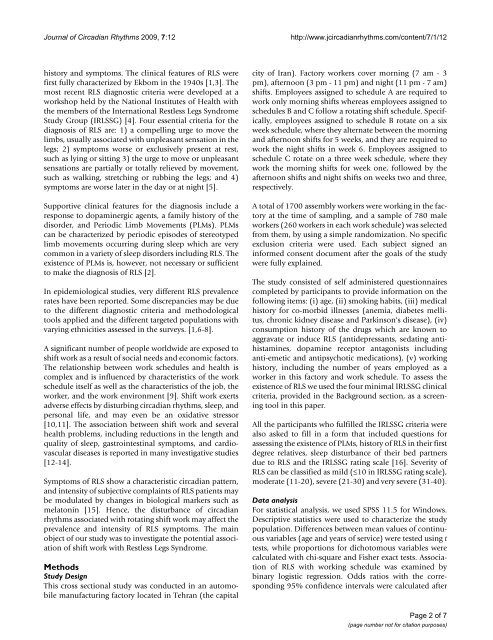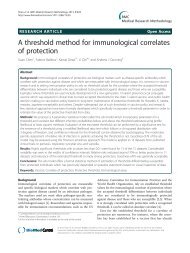Restless Legs Syndrome in shift workers - BioMed Central
Restless Legs Syndrome in shift workers - BioMed Central
Restless Legs Syndrome in shift workers - BioMed Central
Create successful ePaper yourself
Turn your PDF publications into a flip-book with our unique Google optimized e-Paper software.
Journal of Circadian Rhythms 2009, 7:12 http://www.jcircadianrhythms.com/content/7/1/12<br />
history and symptoms. The cl<strong>in</strong>ical features of RLS were<br />
first fully characterized by Ekbom <strong>in</strong> the 1940s [1,3]. The<br />
most recent RLS diagnostic criteria were developed at a<br />
workshop held by the National Institutes of Health with<br />
the members of the International <strong>Restless</strong> <strong>Legs</strong> <strong>Syndrome</strong><br />
Study Group (IRLSSG) [4]. Four essential criteria for the<br />
diagnosis of RLS are: 1) a compell<strong>in</strong>g urge to move the<br />
limbs, usually associated with unpleasant sensation <strong>in</strong> the<br />
legs; 2) symptoms worse or exclusively present at rest,<br />
such as ly<strong>in</strong>g or sitt<strong>in</strong>g 3) the urge to move or unpleasant<br />
sensations are partially or totally relieved by movement,<br />
such as walk<strong>in</strong>g, stretch<strong>in</strong>g or rubb<strong>in</strong>g the legs; and 4)<br />
symptoms are worse later <strong>in</strong> the day or at night [5].<br />
Supportive cl<strong>in</strong>ical features for the diagnosis <strong>in</strong>clude a<br />
response to dopam<strong>in</strong>ergic agents, a family history of the<br />
disorder, and Periodic Limb Movements (PLMs). PLMs<br />
can be characterized by periodic episodes of stereotyped<br />
limb movements occurr<strong>in</strong>g dur<strong>in</strong>g sleep which are very<br />
common <strong>in</strong> a variety of sleep disorders <strong>in</strong>clud<strong>in</strong>g RLS. The<br />
existence of PLMs is, however, not necessary or sufficient<br />
to make the diagnosis of RLS [2].<br />
In epidemiological studies, very different RLS prevalence<br />
rates have been reported. Some discrepancies may be due<br />
to the different diagnostic criteria and methodological<br />
tools applied and the different targeted populations with<br />
vary<strong>in</strong>g ethnicities assessed <strong>in</strong> the surveys. [1,6-8].<br />
A significant number of people worldwide are exposed to<br />
<strong>shift</strong> work as a result of social needs and economic factors.<br />
The relationship between work schedules and health is<br />
complex and is <strong>in</strong>fluenced by characteristics of the work<br />
schedule itself as well as the characteristics of the job, the<br />
worker, and the work environment [9]. Shift work exerts<br />
adverse effects by disturb<strong>in</strong>g circadian rhythms, sleep, and<br />
personal life, and may even be an oxidative stressor<br />
[10,11]. The association between <strong>shift</strong> work and several<br />
health problems, <strong>in</strong>clud<strong>in</strong>g reductions <strong>in</strong> the length and<br />
quality of sleep, gastro<strong>in</strong>test<strong>in</strong>al symptoms, and cardiovascular<br />
diseases is reported <strong>in</strong> many <strong>in</strong>vestigative studies<br />
[12-14].<br />
Symptoms of RLS show a characteristic circadian pattern,<br />
and <strong>in</strong>tensity of subjective compla<strong>in</strong>ts of RLS patients may<br />
be modulated by changes <strong>in</strong> biological markers such as<br />
melaton<strong>in</strong> [15]. Hence, the disturbance of circadian<br />
rhythms associated with rotat<strong>in</strong>g <strong>shift</strong> work may affect the<br />
prevalence and <strong>in</strong>tensity of RLS symptoms. The ma<strong>in</strong><br />
object of our study was to <strong>in</strong>vestigate the potential association<br />
of <strong>shift</strong> work with <strong>Restless</strong> <strong>Legs</strong> <strong>Syndrome</strong>.<br />
Methods<br />
Study Design<br />
This cross sectional study was conducted <strong>in</strong> an automobile<br />
manufactur<strong>in</strong>g factory located <strong>in</strong> Tehran (the capital<br />
city of Iran). Factory <strong>workers</strong> cover morn<strong>in</strong>g (7 am - 3<br />
pm), afternoon (3 pm - 11 pm) and night (11 pm - 7 am)<br />
<strong>shift</strong>s. Employees assigned to schedule A are required to<br />
work only morn<strong>in</strong>g <strong>shift</strong>s whereas employees assigned to<br />
schedules B and C follow a rotat<strong>in</strong>g <strong>shift</strong> schedule. Specifically,<br />
employees assigned to schedule B rotate on a six<br />
week schedule, where they alternate between the morn<strong>in</strong>g<br />
and afternoon <strong>shift</strong>s for 5 weeks, and they are required to<br />
work the night <strong>shift</strong>s <strong>in</strong> week 6. Employees assigned to<br />
schedule C rotate on a three week schedule, where they<br />
work the morn<strong>in</strong>g <strong>shift</strong>s for week one, followed by the<br />
afternoon <strong>shift</strong>s and night <strong>shift</strong>s on weeks two and three,<br />
respectively.<br />
A total of 1700 assembly <strong>workers</strong> were work<strong>in</strong>g <strong>in</strong> the factory<br />
at the time of sampl<strong>in</strong>g, and a sample of 780 male<br />
<strong>workers</strong> (260 <strong>workers</strong> <strong>in</strong> each work schedule) was selected<br />
from them, by us<strong>in</strong>g a simple randomization. No specific<br />
exclusion criteria were used. Each subject signed an<br />
<strong>in</strong>formed consent document after the goals of the study<br />
were fully expla<strong>in</strong>ed.<br />
The study consisted of self adm<strong>in</strong>istered questionnaires<br />
completed by participants to provide <strong>in</strong>formation on the<br />
follow<strong>in</strong>g items: (i) age, (ii) smok<strong>in</strong>g habits, (iii) medical<br />
history for co-morbid illnesses (anemia, diabetes mellitus,<br />
chronic kidney disease and Park<strong>in</strong>son's disease), (iv)<br />
consumption history of the drugs which are known to<br />
aggravate or <strong>in</strong>duce RLS (antidepressants, sedat<strong>in</strong>g antihistam<strong>in</strong>es,<br />
dopam<strong>in</strong>e receptor antagonists <strong>in</strong>clud<strong>in</strong>g<br />
anti-emetic and antipsychotic medications), (v) work<strong>in</strong>g<br />
history, <strong>in</strong>clud<strong>in</strong>g the number of years employed as a<br />
worker <strong>in</strong> this factory and work schedule. To assess the<br />
existence of RLS we used the four m<strong>in</strong>imal IRLSSG cl<strong>in</strong>ical<br />
criteria, provided <strong>in</strong> the Background section, as a screen<strong>in</strong>g<br />
tool <strong>in</strong> this paper.<br />
All the participants who fulfilled the IRLSSG criteria were<br />
also asked to fill <strong>in</strong> a form that <strong>in</strong>cluded questions for<br />
assess<strong>in</strong>g the existence of PLMs, history of RLS <strong>in</strong> their first<br />
degree relatives, sleep disturbance of their bed partners<br />
due to RLS and the IRLSSG rat<strong>in</strong>g scale [16]. Severity of<br />
RLS can be classified as mild (≤10 <strong>in</strong> IRLSSG rat<strong>in</strong>g scale),<br />
moderate (11-20), severe (21-30) and very severe (31-40).<br />
Data analysis<br />
For statistical analysis, we used SPSS 11.5 for W<strong>in</strong>dows.<br />
Descriptive statistics were used to characterize the study<br />
population. Differences between mean values of cont<strong>in</strong>uous<br />
variables (age and years of service) were tested us<strong>in</strong>g t<br />
tests, while proportions for dichotomous variables were<br />
calculated with chi-square and Fisher exact tests. Association<br />
of RLS with work<strong>in</strong>g schedule was exam<strong>in</strong>ed by<br />
b<strong>in</strong>ary logistic regression. Odds ratios with the correspond<strong>in</strong>g<br />
95% confidence <strong>in</strong>tervals were calculated after<br />
Page 2 of 7<br />
(page number not for citation purposes)

















